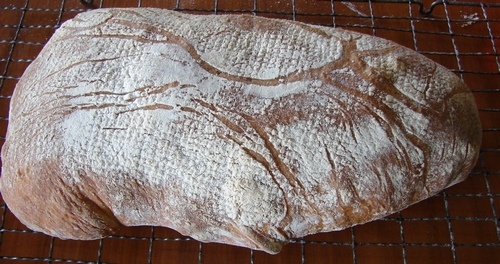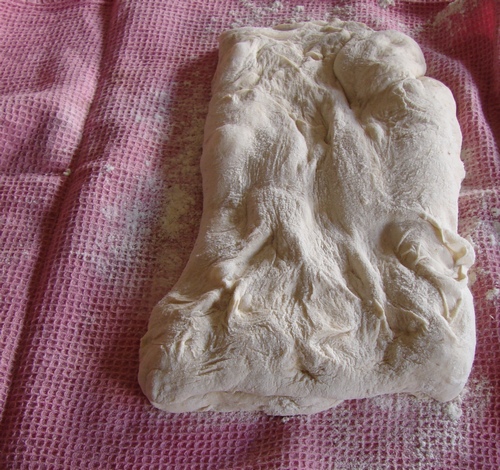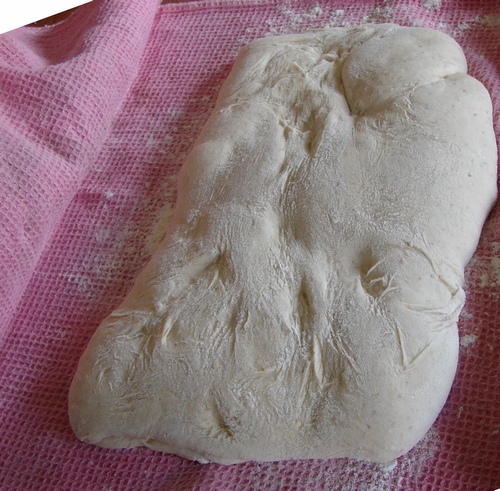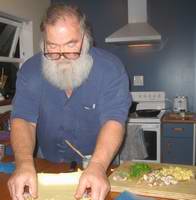The original of this recipe is from the website of Joe Pastry and has been adapted to my own eccentric practice .(This is an inspirational website for bakers and you should visit.) The results I have had for this recipe have been excellent, but it is at the opposite end of the energy spectrum from my Dutch Oven bread. The recipe is simple to follow, but is energy- and attention-intensive over several hours.

We start the day before by making a biga from flour, water and yeast. The purpose of a biga is to develop flavour in the bread by allowing a portion of the dough to ferment for up to 24 hours beforehand. Joe includes a little rye flour and wholemeal in his biga, to generate a rustic quality in the bread, but I prefer straight white for this recipe.
To make a biga, mix
1 1/2 tsp active dry yeast
2 cups bread flour
1 cup water
until thoroughly combined. Set aside to rise for at least 4 hours and up to 24 hours at room temperature. If kept in the fridge, this part of the process can be stretched out to 5 days.
Next we combine the biga with
2 cups warm water
3.75 cups bread flour
1.5 teaspoons rock salt
in the bowl of an electric mixer. First oil the dough hooks to prevent the dough climbing up them. Add the water and salt, and start the beater on slow setting, then add the flour, first 3 cups full, then the last 0.75 of a cup a little at a time with the beater still on low setting, until the mixture is uniform. At this point we pay attention to the kind of dough we want. This is a medium wetness dough. For larger pores in the bread, add a little less flour or a little more water, and be sure you use a baking stone. For a fine pore bread, use a slightly drier mix and bake on a biscuit sheet.
Continue beating for 15 minutes by which time the surface of the dough will be shiny, and the dough will not be sticking to the side of the bowl, just the bottom of it. Place the dough in an oiled bowl and leave to rise until doubled.
Now we form the ciabatta. Use just enough pressure on the dough in the bowl to deflate it. Remove carefully from the bowl and divide into four pieces. Joe divides the dough into two, but each baked loaf is then as large as a computer keyboard.
On a lightly floured surface, flatten each piece of dough with your fingers into a longish rectangle and them fold one third towards the other end and the remaining third over the double layer. Stretch the dough along its long axis. this aids in the formation of the large pores in the loaf which is characteristic of ciabatta. (This is part of the reason a ciabatta is sliced horizontally, so that the crust prevents any filling that has fallen though an extra large pore from actually reaching your lap.)

Place each ciabatta on a clean teatowel covered in flour, cover with the other half of the tea towel and leave to rise. At the same time, set the oven to 250C, and place your baking stone in the oven. At present, I use a couple of eight inch tiles made from biscuit pottery, which allows one loaf per sitting. Under the oven rack, place a roasting dish, and when you slide the ciabatta into the oven, toss a cup of cold water into the dish. The steam helps with crust quality.
When the ciabatta has risen,

place a hand under the teatowel and gently tumble the loaf onto a floured board, or pizza peel, and slide the loaf off the board and onto the hot baking stone. Close the oven door and drop the oven temperature to 220C. Bake for 25 minutes and then turn the ciabatta over and bake 5 minutes more so that the bottom becomes crusty instead of soft. (Using my baking tiles produced a very soft bottom on the loaf)
I do one large/two small loaves at a time, taking the temperature up to 250C between loaves, but will probably experiment with two/four at a time when I get my new baking stone. Allow to cool before setting up a sandwich such as might have been pioneered by Dagwood himself. If you want to grill it as well for a regulation panini that's fine, but fresh and untoasted is good, especially if it is still a tad warm from the oven. It's equally good in winter along with a bowl of soup. Leave enough ciabatta to mop up the last of the soup in your bowl.



